Listen on: Apple Podcasts | Spotify
Cinderella wasn’t referring to a torn bicep when they sang the 80’s rock ballad, “Don’t Know What You’ve Got ‘Til It’s Gone,” but that song title is #truth when it comes to a ruptured biceps tendon. You don’t give much thought to how valuable your bicep is in everyday movement until it’s no longer attached to your forearm. In a fraction of a second, and with the sound of a gunshot, your arm goes from feeling strong and functional to weak and flaccid.
After getting over the disbelief, your mind moves to the reality of surgery and the recovery process. When done right, your recovery can return your arm to its previous strength and function. Done wrong, your recovery process can leave you with subpar strength, reduced range of motion, and a thick and ropey tendon layered in scar tissue.
- Prevalence of Distal Biceps Tendon Ruptures
- Frequently Asked Questions About Torn Bicep Tendons (Distal Biceps Tendon Ruptures)
- Recovery From Biceps Tendon Reattachment Surgery
- Weight Lifting While Recovering From a Torn Bicep Tendon
- Nutrition While Recovering From a Distal Biceps Tendon Rupture
- Supplementation For a Torn Biceps Tendon
- Other Lifestyle Hacks to Enhance Recovery
- Professional-Level Physical Therapy & Rehab
- Patience
Prevalence of Distal Biceps Tendon Ruptures
Distal biceps tendon ruptures occur in one to three out of every 100,000 patients each year, with middle-aged men making up most of the cases.
As hard as it is to believe, the first reported biceps reattachment took place in 1898! I wonder who drew the short straw for that surgeon to try out the new surgery.
Though it sucks when it happens, you can get back to lifting, playing, and posing in your underwear (if that’s your thing), in a short period of time. A good surgeon, and a solid rehab and recovery program can get you close to the strength, endurance, and muscle size you had before you tore it.
Of course, this all hinges on your willingness to work hard during the recovery period.
As common as it is for people to tear their biceps tendon, there isn’t much information on how to maximize recovery. So, I thought I’d put together an article to that does just that.
I’ll start with a few frequently asked questions.
Frequently Asked Questions About Torn Bicep Tendons (Distal Biceps Tendon Ruptures)
Before I delve into the recovery strategies, let me answer some common questions. Chances are, you’re reading this because you just tore your bicep (or you know someone who did) and need to know how to deal with it.
Do you have to get your biceps tendon reattached?
It’s possible to lift your arm and hold your spouse’s hand without getting your tendon reattached. However, you probably won’t be opening pickle jars or rock climbing up the same cliffs with the same confidence if you skip surgery.
Your bicep turns your hand out (supination) as well as helps lift your forearm and hand toward your shoulder (elbow flexion). A ruptured tendon reduces supination strength by 40-60%, and elbow flexion strength by 30%. While it isn’t life-threatening, you’ll find that it’s inconvenient. The investment in surgery right away will be worth it.
I only have a partial tear. Should I still do surgery?
In many ways, a partial tear is worse. With part of the tendon still attached, you’re more likely to experience pain when you use your arm, and you’re more likely to end up tearing it down the road anyway.
The bigger issue is, if you wait to do surgery, you end up with fraying of the tendon, which makes it difficult for a surgeon to reattach it. If you opt for immediate surgery, your surgeon will cut the rest of the tendon and clean it all up before reattaching it, making it more likely you’ll have a successful outcome.
If I have it reattached, what is the chance that I’ll tear it again?
If your surgery goes well, and you follow a solid post-surgery plan, it isn’t likely. Only 1.5% to 1.6% of patients re-rupture their biceps tendon.
How soon after a rupture should I have surgery?
As soon as possible. The longer you wait, the more your bicep retracts up your arm, and the more painful it will be to pull it back down. If you wait too long, it probably won’t be worth it. Get into surgery in two weeks or less if possible.
What can I do to heal and rebuild my strength and function as fast as possible?
Read on. That’s what the rest of this article is all about.
Can I still workout with a torn bicep tendon?
“Can I still workout with a torn bicep tendon?” If you exercise regularly, this is probably one of the first questions that comes to mind. You can, and should still workout with a torn biceps tendon, but avoid exercises that directly involve that arm’s biceps muscle. The hormonal effects of strength training can help speed up the recovery process, which is why you should still workout when you’re injured. Train your lower body as usual, and do single-arm movements with your upper body using your uninjured arm. Don’t let the injury become an excuse to avoid exercise. That will do more harm than good.
I Tore My Biceps Tendon Too
I tore my left distal biceps tendon in July, 2014, at the age of 37. That was two years after I had torn my Achilles’ tendon.
When I tore the Achilles’, I ended up with an average physical therapist, and minimal guidance beyond a few calf stretches, which I already knew. Unfortunately, the calf never regained its full strength or flexibility, and the tendon is a thick mass of scar tissue today.
When I tore my biceps tendon, I was determined to do whatever it took to return it to its pre-ruptured state. I used what I’ll refer to as a “shotgun approach.” I tried everything I could that might have a positive impact on the recovery.
Six months after surgery, I was back to deadlifting in the 400s, and doing normal, full-range of motion pull-ups. That was half the time the surgeon said it would take.
Before we delve into the details, I do need to preface this article with a disclaimer:
Follow the advice of your surgeon, rehab specialist, and any other professional who is working with you hands-on. The rate of your recovery will depend on the quality of the rehab you invest in, the level of your fitness before the injury, your level of activity and exercise following surgery, and the quality of your nutrition and sleep. This article is for educational purposes only, and is not to be taken as medical advice or prescription.
Before we delve into the details, I do need to preface this article with a disclaimer:
Follow the advice of your surgeon, rehab specialist, and any other professional who is working with you hands-on. The rate of your recovery will depend on the quality of the rehab you invest in, the level of your fitness before the injury, your level of activity and exercise following surgery, and the quality of your nutrition and sleep. This article is for educational purposes only, and is not to be taken as medical advice or prescription.
Recovery From Biceps Tendon Reattachment Surgery
Normally, when I offer nutrition and fitness guidance, I recommend trying one or two new things at a time to see how your body responds. Following an injury, though, I do see value in a shotgun approach: Throw everything at it that you can, knowing that at least some of it will be effective.
You don’t have time to slowly and methodically see if extra amino acids are helpful, or whether you like cryotherapy. The goal is to get the injury recovered as fast as possible, so you can get your life back to normal. Also, the longer it takes to rehab, the less likely it is that you’ll regain the same quality of function you had pre-injury.
Post-Surgery Inflammation
Minimizing inflammation and restoring supination and pronation following surgery are critically important, which reduces the risk of heterotopic ossification. Heterotopic ossification is the growth of bone tissue. Some patients grow bone between the ulna and radius (the two bones in the forearm), which reduces or can prevent supination and pronation of the forearm. This is more common in the two-incision method, which was the surgery I had. Most surgeons stress the importance of minimizing inflammation. Unfortunately, the only recommendation they usually provide is a prescription for anti-inflammatory drugs.
I’ll break this down by exercise, nutrition, supplementation, and lifestyle choices to consider. The goal of your recovery is to:
- Minimize inflammation
- Restore range of motion
- Rebuild muscle and connective tissues
- Restore strength and muscular endurance
Weight Lifting While Recovering From a Torn Bicep Tendon
Weight training stimulates production of hormones like testosterone and growth hormone, both important for tissue repair. Research also shows that if you train part of your body while another part is immobilized, you’ll slow your loss of lean mass.
I tore my bicep on a Monday morning, doing deadlifts. After seeing a surgeon later that day, he scheduled my surgery for Thursday. So, I got back in the gym on Tuesday and Wednesday, with my arm in a sling, and trained the rest of my body. One day was legs, the other was the right side of my upper body. Thursday was the surgery, and I took Friday off, and then I was back in the gym on Saturday.
Unfortunately, most people turn their injury into an excuse to stop exercising. That’s stupid. The very same hormones and immune system responses that help rebuild tissue in an uninjured exerciser also help speed the recovery in someone who is injured.
Leg workouts are especially potent for driving up testosterone and growth hormone, so I recommend at least two leg workouts per week following surgery.
Depending on the type of gym you train at, you can do almost any exercise you’d normally do. You just need to avoid using or leaning on your injured arm.
Ask if there’s a safety squat bar available. This bar is unique in that it has sort-of a collar with handles that stick out by your face. You can easily hang on with one hand, and do your normal barbell squats.
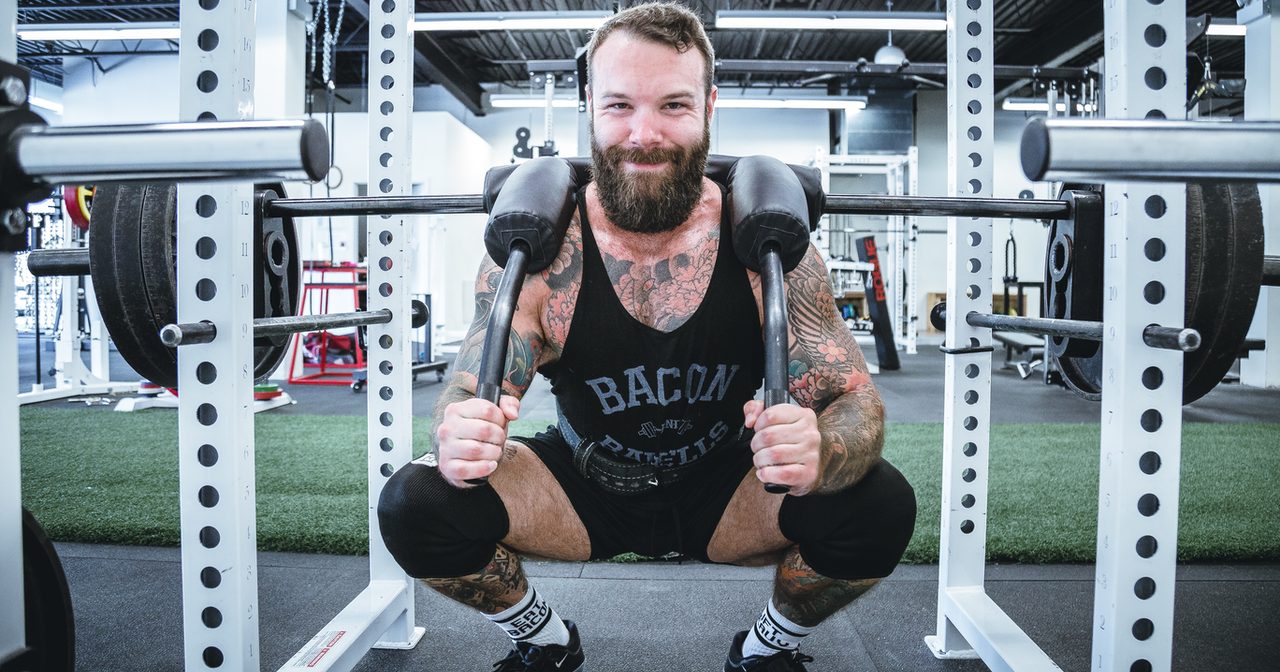
If there isn’t a safety squat bar, the next best thing would be a Smith machine. Normally, I don’t like the Smith machine as the single plane of motion isn’t natural, but you don’t have to worry about the bar tipping off your shoulders. Leg presses, hack squats, seated leg curls, extensions and calf raises are all easy to do with your arm in a sling, cast, or immobilizer. Keep the rest periods relatively short, and the reps on the higher end (10-15). This creates a more potent stimulus for hormone production.
Of course, for upper body exercises, you can do almost everything on the uninjured side with dumbbells and cables: single-arm chest presses, pull-downs, overhead presses, rows, lateral raises, etc. I found that I could even do some lateral raises and lat work with my injured arm, provided I kept my bicep relaxed.
The bottom line is this: You can continue to weight train. In fact, you should keep weight training throughout the recovery process. Within a few months, you’ll probably begin doing the same exercises on your recovering arm as you’re doing with your healthy arm, just with lighter weights.
I know it’ll be a little scary once you start adding resistance to your tendon, but for your tendon to regrow properly, you have to expose it to progressively greater resistance, through whatever range of motion you’re capable of.
Once I was able to add light resistance to my recovering arm, I stopped into our building’s fitness center every day and did a set of 10 bicep curls and 10 tricep press-downs, adding a little weight each week, until my left, injured arm, caught up with my right arm.
Read also: Gym Workout Routines For Beginners and Intermediates
Nutrition While Recovering From a Distal Biceps Tendon Rupture
From a dietary standpoint, you can do much to minimize inflammation and provide micro and macronutrients necessary for muscle and connective tissue growth.
In my opinion, a post-surgery diet should be low-carb, high-protein, gluten-free, and dairy-free (with one exception). Again, minimal inflammation and maximum nutrients to recover.
High-quality animal protein and non-starchy vegetables would make up most of your diet. The exception on dairy would be whey protein. If you tolerate it, use it. It is potent for stimulating protein synthesis. However, if it upsets your stomach or you react to it, don’t mess with it, as it could cause unnecessary inflammation.
I’d also recommend bone broth, as it contains collagen and other connective tissue building blocks. Vanessa, my wife, made batches of bone broth, and I drank a couple of coffee cups full most days during my recovery.
Until you can start using your bicep again for exercise, keep the carbs to a minimum.
Supplementation For a Torn Biceps Tendon
This is where the “shotgun” approach really comes in.
The way I see it, there are numerous compounds, constituents, botanicals, and oils that support tissue regeneration, normal inflammatory levels, and injury recovery. You don’t have the time to test one supplement at a time to see how well it works for you. If research supports its use, it won’t hurt to include it.
1. The Foundational Five
I’ve mentioned my “Foundational Five” in numerous other articles. While they’re always important, they’re even more important when you’re under physical or mental stress, or recovering from an injury. These five supplements are the best supplements to support your health in general.
A high-quality multivitamin ensures you get enough of most of the micronutrients necessary for cellular health, metabolic function, and tissue repair.
Fish oil is well-known for its effect on supporting a normal inflammatory response. I took 18 grams of fish oil per day for the first few months following my surgery. I know some practitioners would recommend even more, but if you’re avoiding most processed foods high in omega-6 fatty acids, that’s probably plenty.
Magnesium and vitamin D are also part of the Foundational Five. Magnesium is required for muscle contraction, among many other things, and maintaining optimal vitamin D also helps support normal levels of inflammation.
Finally, digestive enzymes are the fifth of my Foundational Five, and help support optimal digestion and assimilation of the nutrients you eat through whole food.
2. Essential Amino Acids
Connective tissue, like your biceps tendon, is made of amino acids. Essential amino acids need to come from your diet, as your body cannot make them on its own. Animal-based proteins are rich in amino acids.
You get the building blocks of muscle and connective tissue by eating…muscle and connective tissue.
I already mentioned the importance of a high-protein diet, but you can bump up your amino acid intake even more by supplementing with essential amino acids.
Aside from slowing the loss of muscle, and supporting the rebuilding of your bicep, amino acids offer another interesting benefit. Essential amino acids stimulate mitochondrial biogenesis, the growth of new mitochondria.
Mitochondria are the powerhouses of your muscle cells. When a muscle is immobilized, it loses mitochondria. After a couple of weeks in a cast, your shriveled arm will have lost a large portion of its powerhouses. Essential amino acid supplementation, along with your rehab and strength training program, can help restore your lost mitochondria.
I took 15-20 grams of essential amino acids, which were mostly branched-chain amino acids, as part of my recovery plan.
Read also: Amino Acids: What You Need To Know
3. Proteolytic Enzymes
While I knew of digestive enzymes since my college nutrition courses, I hadn’t heard of proteolytic enzymes until about ten years ago. A friend who worked for a practitioner-based supplement company told me about Wobenzym, a European-based product commonly used for dealing with occasional pain, injury recovery, and to support normal inflammation levels.* (You can order Wobenzym with a Wellevate account).
Proteolytic (protein-splitting) enzymes help break down protein. They aid in the digestion and assimilation of dietary protein.
However, when supplemental proteolytic enzymes are taken on an empty stomach, they are absorbed into the circulation and have health-promoting effects on various tissues. They help accelerate the breakdown of damaged tissue, assisting the immune system in healthy tissue regeneration.
Trypsin, bromelain, and rutin are three of the most-researched for connective tissue health, but other enzymes may also have positive effects. A high-quality, digestive enzyme product could do the trick for you as well. In order to benefit from them, though, they must be taken on an empty stomach, at least 45 minutes before meals or snacks.
4. Type I Collagen
Type I collagen makes up most of the collagen found in the human body, including tendons. By drinking bone broth, or supplementing with type I collagen, you provide the building blocks for tendon tissue, as well as many other tissues throughout the body.
Don’t mistake type II for type I though. Type II is beneficial for supporting cartilage growth and slowing the progression of osteoarthritis, but type II collagen is not involved in tendon tissue growth.
Most of the popular collagen powder supplements have a mix of collagens, with most of the collagen coming from type I.
5. Curcumin
Curcumin, a constituent of turmeric, supports normal inflammatory levels.
Of course, non-steroidal anti-inflammatory drugs (NSAIDs) lower inflammation, but they interfere with muscle growth as well.
Curcumin affects a different aspect of inflammation than NSAIDs, so it can support normal inflammation while not interfering with muscle growth.
Animal research shows curcumin also assists with muscle tissue regeneration.
The health benefits of curcumin come with a caveat though. Most curcumin is poorly absorbed. Read Curcumin: Health Benefits of Turmeric’s Key Compound to learn which forms of curcumin are best.
6. Glutamine
Glutamine, a conditionally-essential amino acid, increases production of glutathione, the body’s primary antioxidant. It also supports wound healing, making it a great add for your post-op biceps tendon recovery.
I used 10 grams of glutamine a day after my surgery.
7. Vitamin C
Vitamin C, or ascorbic acid, is a co-factor for collagen synthesis. The following is directly from one of the papers found in the references below:
Wounds create an environment of higher catabolic state. Following injury, the rate which micronutrients are metabolised increases significantly often leading to critical deficiencies. Indeed, levels of vitamin C, a small, organic, water-soluble micronutrient with strong antioxidant properties, fall rapidly during inflammation.
Mohammed, et al.
Doses of one to two grams of ascorbic acid are common to support wound healing.
8. Essential Oils
I used a lot of essential oils throughout my recovery, in the diffuser, topically, and internally. And though they offer numerous health benefits, it’s difficult to write about the benefits in an article like this.
Essential oils are regulated as either dietary supplements or cosmetics. When recommending essential oils as dietary supplements, it’s okay to suggest health benefits such as supporting normal inflammatory levels or supporting the immune system. However, when used topically, they’re considered cosmetics, and cosmetics cannot carry claims other than being good for your skin.
I did use frankincense essential oil on my two incisions to promote healing and healthy skin. It worked really well.
Inhalation of oils in research also has numerous physiological effects, but I cannot say much beyond the fact that they smell nice and help support a good mood and emotional state.
I do believe they can play an important role in your recovery, so please don’t dismiss their benefits. If you’re not convinced, invest a little time in PubMed.
Read also: Essential Oils: What Happened To The Hype?
Though it wasn’t available when I tore my bicep in 2014, I do recommend the Cool Azul Pain Relief Cream by Young Living as a powerful, topical product during the recovery process, especially following physical therapy or rehab treatments, as you’ll feel more sore than normal following your sessions.
The Cool Azul Pain Relief Cream is recommended for relief of minor aches and pains of muscles and joints associated with strains, sprains, and bruises, so I’d say this would be a good use for it.
9. Methylsulfonylmethane (MSM)
Methylsulfonylmethane (MSM) has been used as an alternative therapy since the late 1970s. MSM is a source of organic sulfur for the body, and unlike many supplemental compounds, it is absorbed very well.
MSM is a powerful antioxidant, and supports normal inflammatory levels, may alleviate occasional pain caused by arthritis, helps preserve cartilage, and may even help with seasonal allergies.
Of course, the reason you’re reading this is to care for your bicep, and MSM is something to consider based on its effects on normal inflammation levels and its antioxidant power.
Other Lifestyle Hacks to Enhance Recovery
You’ve got the diet down. The supplements are easy to add. Hopefully, you’ll commit to continuing your normal weight training routine with your uninjured limbs. But the lifestyle choices seem to be the biggest roadblocks to a fast recovery.
I’m not going to mislead you. Most of these take extra time. Some cost extra money.
I can understand why some people skip out on most of them, but at the same time, I want you to know what you can do to enhance your recovery, and then let you decide how much more you’re willing to do.
1. Sleep
In terms of lifestyle choices, this one trumps them all. When you’re recovering from an injury, you need sleep. After all, it’s during sleep that you produce the most growth hormone, the key hormone that influences muscle growth and tissue repair.
To understand the importance of sleep, and how to get enough, read Sleep Now Or Pay Later: The Significance Of Sleep And How To Get More Of It.
2. Sauna
Your body responds to environmental stress by secreting cortisol, growth hormone, adrenaline, noradrenaline, and growth factors.
The sauna has also been shown to reduce pain and lower levels of inflammation throughout the body. That’s just one of the seven benefits of the sauna.
I used the sauna for 30-40 minutes with a break in between, a couple of times per week during my recovery.
3. Cryotherapy
Like the sauna, cryotherapy causes a heat stress response. However, instead of 20 minutes of exposure to high heat, you spend three minutes or less, exposed to cold temperatures as low as (-)290°F. Yes, that’s minus two hundred ninety degrees Fahrenheit.
Don’t worry though. It’s like being in Phoenix in the summer. It a dry heat, err, cold.
The extreme cold triggers a stress and immune response, and since you’re only in the cryotherapy unit for three minutes or less, you don’t get frostbite. Cryotherapy can also improve sleep quality at night following your session, and can raise metabolic rate. It’s actually a great addition to a fat loss program, especially for those with significant weight loss goals and high levels of pain and inflammation.
I have to tell you though, I could literally feel my arm relax and the swelling go down in my cast as I stood in the cryotherapy unit. It was one of my favorite parts of my day in terms of my recovery.
If you have access to cryo, I’d recommend three days per week for the first four weeks, then twice a week for the next month, and once a week after that, for as long as you feel like continuing.
4. Stem Cell Injections & Platelet-Rich Plasma Therapy
I wouldn’t be able to do justice to how stem cell injections and platelet-rich plasma (PRP) can help in tissue repair in a short overview like this. If this sounds interesting, do some homework. Perhaps, one day I’ll write full articles on each of them.
Stem cells are blank cells that need to be told what to become. When they’re injected into the site of an injury, they can become cells that help form new tissue, like the tendon of your bicep or the fascia that was cut to get to your tendon during surgery.
Stem cells are surrounded in controversy because some come from questionable sources. The company who produced mine got theirs from the placentas of women who donated them after healthy births by c-section. I made sure I didn’t compromise my values to do the therapy.
You can also get stem cells from your own bone marrow, fat tissue and even your blood. Unfortunately, some scientists have used stem cells from aborted fetuses, which makes my stomach turn and causes much of the turmoil around stem cells. However, don’t let that form of stem cell research and therapy cause you dismiss it all.
The research supporting their use is compelling, provided they come from ethical sources.
Platelet-rich plasma is a little different. A doctor draws your blood and spins out the platelets and growth factors. Then, he or she injects those platelets and growth factors directly into the site of an injury, where they can support recovery and reduce inflammation.
Stem cell injections and PRP are often done together as well. I personally did only the stem cell injections.
If I were in this scenario today, I’d contact Dr. Matthew Cook at BioReset Medical. He and his clinic are leading-edge when it comes to alternative sports medicine therapies, including stem cells injections and PRP.
Professional-Level Physical Therapy & Rehab
I thought it was appropriate to address physical therapy and rehab on its own. The way I see it, you’re going to use your bicep for the rest of your life, so you should do your homework when choosing a physical therapist or rehab specialist. You don’t need someone who just graduated from college handling your rehab.
If your physical therapist simply shows you some stretches and teaches you how to lift a soup can, you’ll be sorry.
In fact, your therapy group could be more important than your surgeon. I was fortunate to find Orthology in the Twin Cities. They work with the Minnesota Vikings. Actually, during the week, they’ll have other pro football players fly in for therapy as well. Their job is to get an athlete back to tip-top shape as fast as possible after an injury. That’s a great standard for you as well, Citizen Athlete.
With all that said, expect your physical therapy to be painful. Part of my treatment involved manually aggravating the incision area and the reattachment site to draw in growth factors, break down scar tissue, and avoid the incision from adhering to the tissue underneath it.
It was the most painful thing I’ve ever experienced, often making me sweat, spit, and swear while the therapists just smiled.
The pain of spinal taps and bone marrows at the Mayo Clinic were mild in comparison.
However, it was well worth it. The scar tissue was kept to a minimum, range of motion was restored, and I did my first pull-up nine weeks after surgery, 13 pull-ups at 12 weeks, and deadlifted 405 lbs for three reps at less than six months.
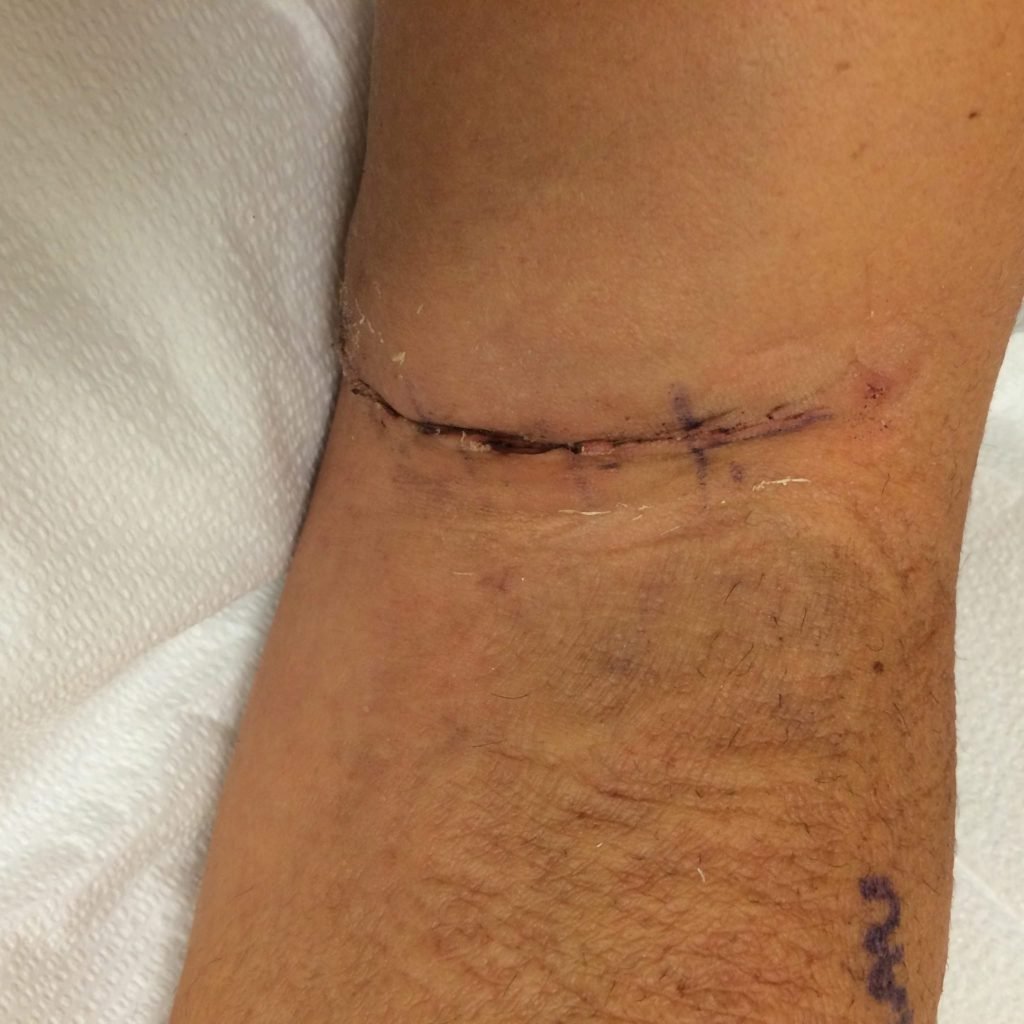
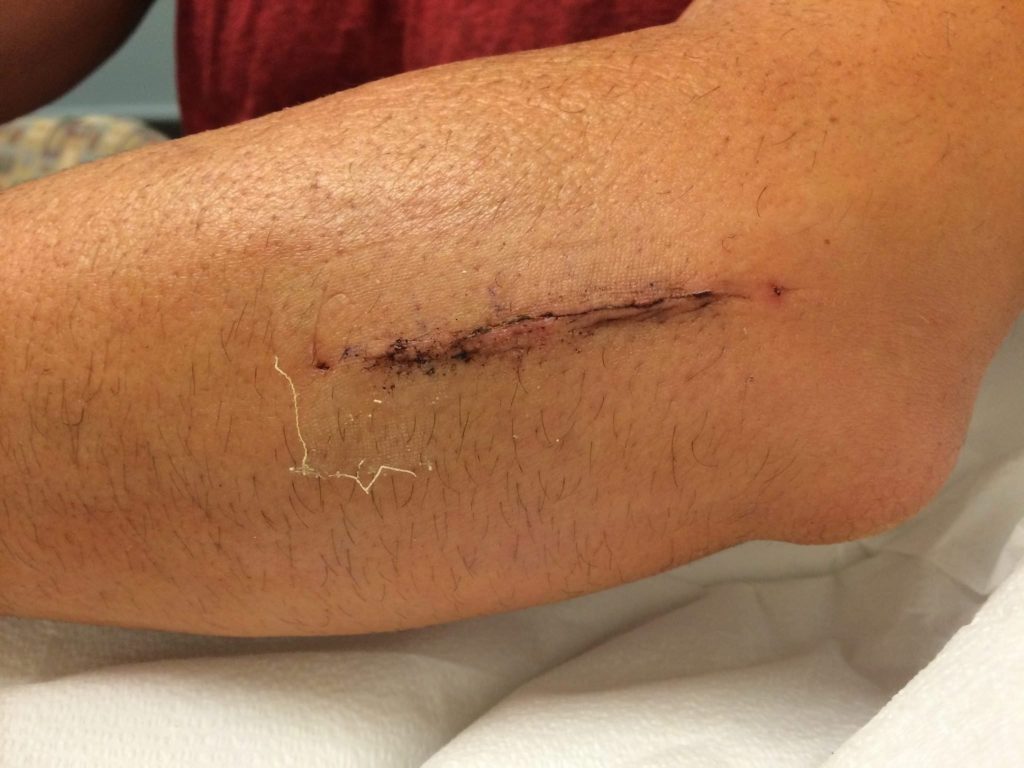
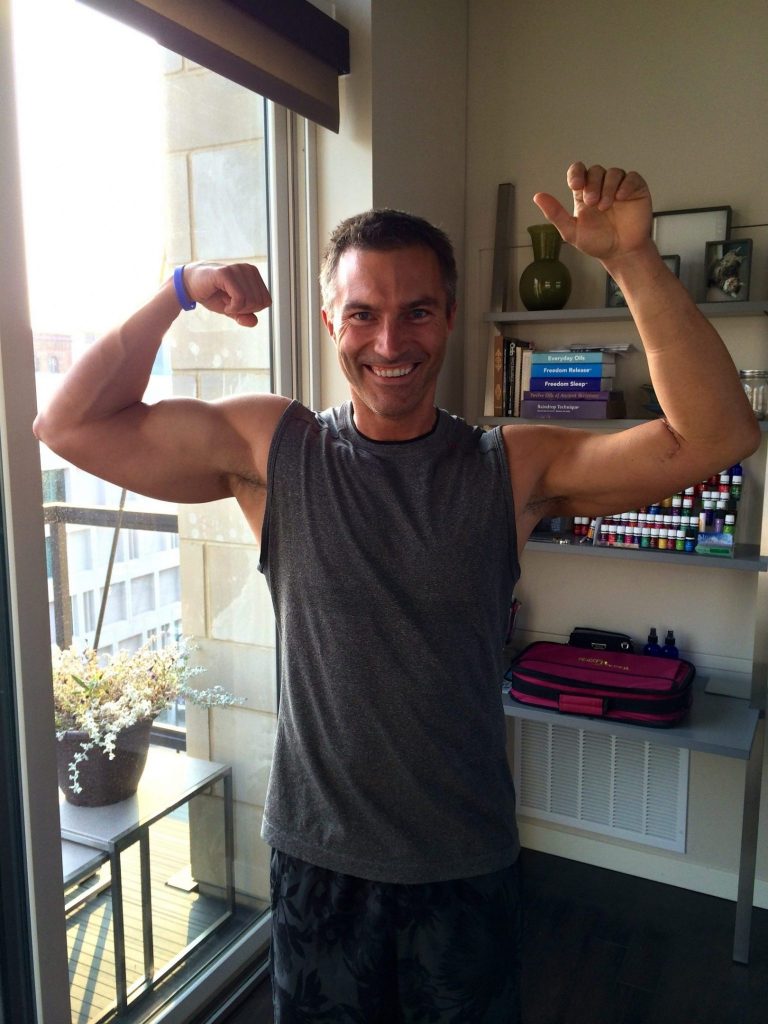
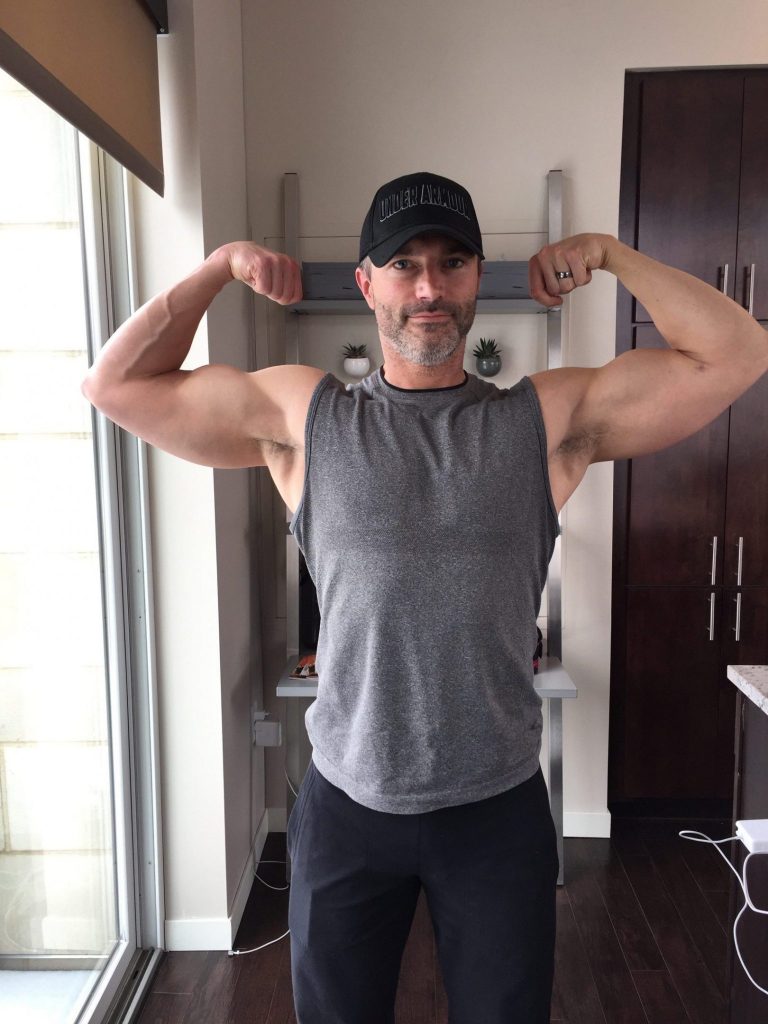
Those numbers might not seem impressive, but I was excited based on how scrawny my arm was after surgery, just six months before.
Patience
When you get home from surgery and imagine six months ahead, it seems like it’ll be forever. Even worse is if you have a surgeon who tells you it’ll take a year to recover.
But, you’ll find the six months flies by, and as long as you are diligent about the nutrition, exercise, supplement, and lifestyle choices outlined in this article, you’ll be as good as ever in no time.
Dang! That was a LONG article wasn’t it? If you made it this far, congrats! I probably still left some questions out, so feel free to ask them in the VIGOR Training Facebook group.
One last thing…please share this article. You probably know someone who tore their bicep (or some other tendon) recently, and they’re wondering what to do. Hopefully, this will “arm” them with answers they’re looking for.




I know myself; I won’t wait that long. I was determined to be running in a month after I tore miniscus. I was running in 3 weeks. After tearing shoulder I was doing pull-ups after 2 weeks. I am not patient at all. Is this going to be a problem? I have to do the same surgery as you.
While I obviously believe you can recover much faster than the standard of care expectations set for people, I also understand that there’s a limit to how fast a tendon can sufficiently rebuild an attachment to the bone. If you have the same procedure as me, I was in a cast for a couple of weeks. There’s no way I would have tried putting stress on the muscle a week after that. If it were a strain or sprain, that’s quite different. That said, if you take advantage of the therapies and natural products I covered in the article, you’ll be back to relatively normal before the year is over.